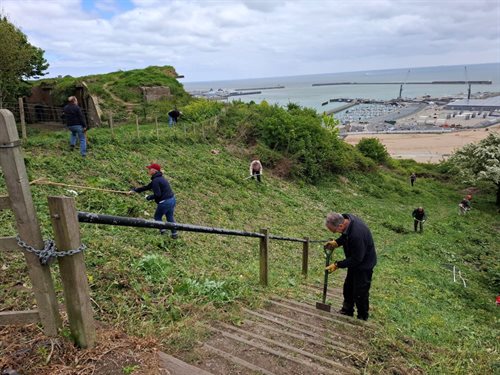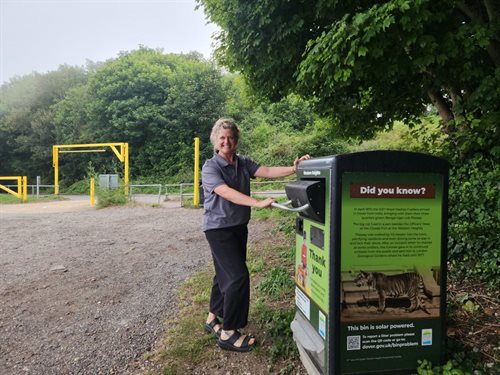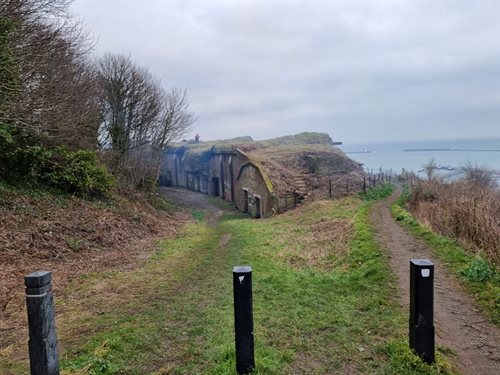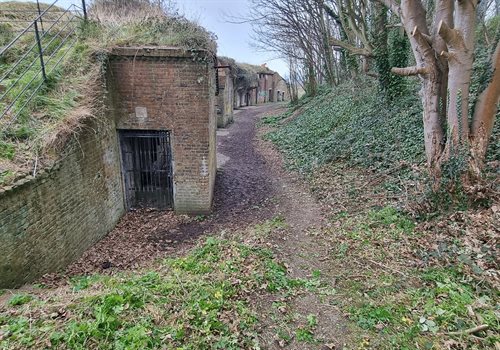
Sarah Horan, DDC's Western Heights Project Officer, updates the information boards.
A major project to transform Dover’s Western Heights is well underway one year on from a funding boost aimed at regenerating and conserving the historic site.
Dover District Council has been working with partners to manage the nationally significant asset, including clearing overgrown vegetation from previously hidden buildings, restoring beautiful views across the coastline and making the area safer.
Most recently, DDC has cleared the Gun Shed area which had been a target for anti-social behaviour. This extensive work has created a safer and more pleasant environment for visitors, and is an important first step towards reusing this space.
Volunteers from the Western Heights Preservation Society and White Cliffs Countryside Partnership have also been working hard to manage the site, helping to clear and transform a huge area at St Martin’s Battery. Buildings have been cleared from overgrown vegetation and stunning views of Dover opened up.

Signage and solar-powered CCTV added in the last year are all helping with the positive management of the Western Heights too, and contribute to reducing antisocial behaviour.
A compactor bin featuring local legend Plassey the Tiger – who was walked around the streets of Dover by his owner during Victorian times – has also been installed.
All this work forms part of a major three-year project which launched a year ago when Historic England awarded DDC a £149,000 grant to support conservation and regeneration work at the Western Heights. This has been match-funded by DDC.
The grant has helped to fund a dedicated project officer to run the programme of works, which involves encouraging more visitors to the site through events, promotion and community engagement, while helping to connect the asset with the town and seafront.

The Western Heights consist of a series of forts linked by miles of ditches on the western hilltop above Dover and it is one of the most important fortifications in Britain.
It includes a scheduled monument, two listed buildings, a conservation area, a local nature reserve with protected species, and a wildlife site with important chalk grassland.
Cllr Lynne Wright, DDC’s Cabinet Member for Corporate Property, said: “The Western Heights is one of the district’s most impressive sites and we are using this project to help us better understand its significance and wider importance to the town.
“The positive management of the asset has been a brilliant opportunity to build strong relationships with our partners. After all, we have the same goal - to enhance and continue to protect the area, and to maintain it as a destination of national and international significance.
“Thank you to the volunteers who have worked hard alongside DDC to clear parts of the site. This has made such a difference already and I hope it encourages more people to visit.”

Alice Brockway, Development Advice Team Leader at Historic England, said: “It’s one year into this exciting three-year project at the Western Heights and we’re delighted with the progress to date.
“Strong partnership working is producing excellent results, with the clearance of vegetation around St Martin’s Battery and the Gun Shed resulting in the biggest visual improvement.
“The phenomenal views have to be seen to be believed so I’d recommend to anyone who hasn’t been to head up to the Heights and experience this extraordinary place in person.”
Notes:
The Western Heights
One of the most important and impressive fortifications in Britain, the Western Heights is a series of strong points linked by miles of ditches on the western hilltop above Dover. It began as a series of field fortifications during the American Revolutionary War (1775-1783), was strengthened and extended in brick during the French Revolutionary and Napoleonic Wars (1792-1815), extended and amended again in the 1860s and finally completed in the 1890s. The Heights was also used for barrack accommodation during the First and Second World Wars, and some of the fortifications adapted for modern warfare.
The Drop Redoubt is one of two independent forts on the Western Heights and is linked to the other, the Citadel, by a series of dry moats, or ‘lines’. It is a large and impressive fortress intended to defend against the attack of an invading force attempting to capture Dover from the north-east.
The Grand Shaft was built during the Napoleonic Wars to link the harbour to the barracks on the Western Heights. The Grand Shaft is a unique 19th century triple staircase built to provide a short cut for troops from the Western Heights to the town.

Posted on 30 June 2025